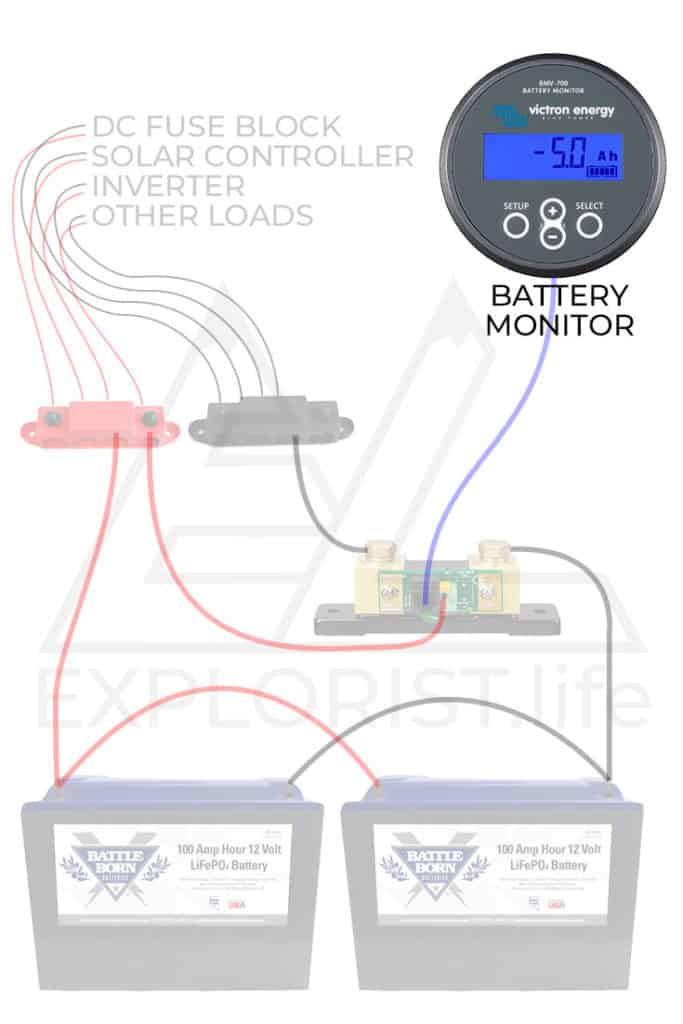

Removing the tanks isn’t a big deal for me, but even with the tanks removed, the load distribution hitch jacks are an obstacle to easy access. To gain access, the propane tanks must be removed first to gain access. Not only are these batteries heavy, they were stored in a somewhat difficult to reach location behind our propane tanks. Plus, when things go bad, they usually happen at the most inopportune time. Keep in mind, assuming I am still alive, I will be 74 years old in three years. I did not relish the idea, that in three years of so, I would have to lift a couple of 62 pound batteries. Each one of our Trojan T-105 batteries weigh 62 pounds. Wired in series, these batteries created a large 12volt battery bank, designed for many discharge/recharge cycles.
#Camper battery monitor letters series
I have been running two 6volt FLA batteries wired in series in our campers for many years. Probably had another 3 years of life left in them. The batteries I replaced were only 3.5 years old and working fine. They are also well suited for use as a RV battery, where the battery is used to power the living space of the RV. LFP batteries are safe if they are not abused or used in a manner that is contrary to the manufacturer’s instructions. LFP batteries are not the batteries we read about when a battery bursts into flames and burns down a house or an electric vehicle. To avoid typing too many letters repetitiously, from this point forward I will refer to LiFePo4 batteries as simply, LFP batteries.
#Camper battery monitor letters upgrade
If you are in the market to upgrade your battery bank, read the specifications of any battery you are considering. Not all lithium-ion batteries are LiFePo4 batteries. It is classified as a lithium-ion type of battery. For an RV application, you probably want a lithium iron phosphate (LiFePo4) battery. There are many kinds of lithium batteries. FLA are the cheapest and provide a minimal advantage in capacity and the number of times it can be recharged.įor this discussion, from this point forward, I will simply refer to all lead-acid batteries as FLA. There are times a SLA or AGM may better fit an application, the lifetime and characteristics are similar. Instead of a large pool of electrolyte, the electrolyte is soaked into a sponge like material between the plates. There is enough space inside the battery to allow the gases to expand and then contract. Same construction as the FLA, except the battery is not vented. Because gases escape, the amount of water in the electrolyte in the battery decreases over a period of time, requiring periodic maintenance, which mostly involves adding distilled water to ensure the to top of the interior plates remained covered with liquid. The simplest is the flooded-lead acid (FLA) battery, which is vented to the atmosphere allowing the gases created during charging to escape. Plates inside the battery are suspended in a liquid electrolyte (“acid”). The simple lead-acid battery has been around for over 150 years. The lithium batteries used to power the living space are not appropriate for starting the engine. One battery system starts the vehicle’s engine and the other powers the living space. With motorhomes, which are self-contained, the living space is also part of the vehicle itself and requires two battery systems. These batteries are much different than a battery used to start a vehicle. Our focus is on the batteries that are used to power the accessories and appliances in a motorhome, travel trailer, 5th wheel, and campers. The conversation is about large batteries (capacity greater than 100 amp hours) that are appropriate for RV use.įirst, let’s set some definitions. This post will share why I made this decision, what I have learned about lithium batteries, some challenges of installation (it wasn’t a simple battery replacement), the significant differences between lithium and flooded lead-acid batteries, and the changes one may have to make to their own systems to maximize their installation.


I upgraded our travel trailer’s 225AH (amp hour) battery bank with a 300AH lithium iron phosphate (LiFePo4) battery.


 0 kommentar(er)
0 kommentar(er)
